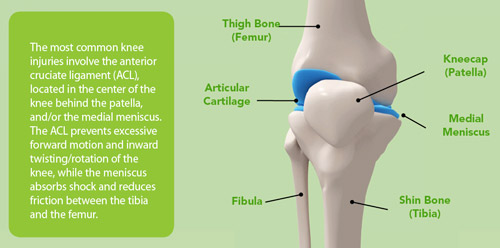To summarize, the way knee injuries are handled in today's world is to stop doing things that tear ligaments, like running, jumping, twisting and stopping quickly. If you do want to continue doing those things, the common recommendation is to get surgery or do rehab and put on a brace to limit motion in the joint. The resulting lack of motion will likely cause degenerative arthritis over the next 20-40 years, which will result in the need for a knee joint replacement.
OK, so where's the good news? Simply put, a chiropractor has the ability to do a better job than that! Their knowledge of the foot, knee, hip and spine connection, combined with practical experience, affords an alternative to the "shoot the dice and hope for the best" theory. The first thing to understand is that healthy knee function is not possible without healthy foot function. The medical model of health care does not take that into consideration because the foot rarely presents itself as being painful. Even if the foot does hurt, treatment only takes care of the symptom and does not address abnormal joint function.
A vast majority of people, young and old, excessively pronate. This means that when the foot hits the ground, it flattens out or unlocks, rolling inward and creating a twisting stress up the leg and into the knee. These twisting stresses do three things to the knees: stretch the ACL, stretch and twist the medial meniscus, and inhibit contraction of the quadriceps muscle.
Every time we take a step, jump, pivot, stop quickly and run, those three things take place. A torn knee ligament is not a one-injury event; it is a multiple micro-injury event. These abnormal forces take place perhaps thousands of times, creating microtrauma to the support structures of the lower leg until the ligament fails catastrophically.
If thigh muscle weakness is one of the results of excessive pronation, doesn't it make sense that the muscle loses its tone to a point that it can no longer stabilize the joint efficiently? Remember, muscle is the primary stabilizer; ligaments are secondary. If you weaken the muscle and traumatize the ligament a few thousand times, you have all the ingredients for the classic knee injury.
Common sense tells us to prevent the excessive damaging motions by supporting the foundational structures (your feet) so they function within the functional range of motion. Many chiropractors now evaluate the quality of the arches of the feet. If the arches aren't supporting the legs and pelvis sufficiently, it can create stresses that lead to injury or joint wear and tear. It's just like the foundation of your house; if it settles too much, it creates stress in other parts of the structure.
Take a proactive step to avoiding injuries and preserving the health of your knees, hips and spine. After all, you know what they say about "an ounce of prevention." Ask your doctor for a thorough foot evaluation, particularly if you're experiencing knee pain or participate in activities that put you at risk for a knee injury.

Brian Jensen, DC, is a graduate of the University of Nebraska and Palmer College of Chiropractic. He specializes in structural biomechanics and has been in practice for 17 years.

